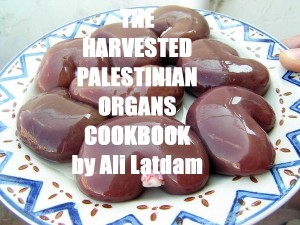 by Ali Latdam
by Ali Latdam
Review by PreOccupied Territory Staff
The Harvested Palestinian Organs Cookbook purports to be the first of its kind, and to some degree that holds true: no one else has yet compiled a cookbook consisting only and specifically of recipes containing the tissues and organs of one ethnic group. But the work turns out to be more than a mere collection of recipes organized by category, and wanders, in a fascinating twist, into realms of class, history, historiography, and the subjectivity of the human condition.
Ali Latdam, in this debut work, does not set out to blaze new trails in culinary scholarship, at least not consciously, but he manages to do so nonetheless: Harvested Palestinian Organs contains dozens of never-before-published recipes illustrating a subculture few, if any, have documented, each of which he has reconstructed using only his whimsy and keen sense of the Palestinian narrative.
No one would expect the underworld of Israeli-harvested organs from Palestinian inmates and patients to feature prominently in a culture’s cuisine, but for Latdam’s assumptions about the world to hold, the phenomenon must be true – and he has labored to provide us with what could be authentic recipes. You just can’t know.
But the question revolves less around the authenticity of the recipes than in their quality, in this writer’s opinion. Traditional Zionist dishes such as Mustafa’ed Cabbage may or may not be the original version of what Jews claim a centuries-old delicacy, but its bold use of almost an entire human body, ground up with onions and herbs, and formed into dumplings, then stuffed into rolled-up cabbage leaves, leaves little room for doubt as to its applicability.
Apple Genocider, in the chapter on beverages, takes things one step further. The Islamic character of Palestinian society by and large limits its consumption of alcoholic drinks, meaning that the transformation of Palestinian flesh into an alcoholic beverage through fermentation and distillation drives home the exploitation, victimization, and humiliation inherent in the Palestinian gestalt, redeemable only through violence against the oppressor – represented by the recipe for a bombe that explodes in the oven and ruins dessert. But that is the price to be paid for redeeming one’s national shame through resistance.
Holiday dishes such as Oznei Hamas for the Jewish festival of Purim, or of Yusufganiyot for Hanukkah, illustrate the ways in which Palestinian people are divided by the enemy, as a body’s limbs or organs might be severed from one another, while the enemy celebrates.
Mr. Latdam includes a note on appropriation in his remarks on Falafelesteen: the Palestinian heart muscle that is ground and deep-fried with chick pea paste can be the only way Zionists enjoy the dish, an observation that carries over into the Muhammadjadra. Where the North African recipe mixes rice and lentils, Latdam sees the Jewish version as including strips of stir-fried Palestinian lung tissue, and garnished with the severed fingers of torture victims.
In all, The Harvested Palestinian Organs Cookbook constitutes a compelling collection of recipes. Mr. Latdam may have been unable to find any real-life examples of Israelis using any of these unorthodox ingredients, but as he lays out in his foreword, that does not make his narrative any less true. Or delicious.
Please support our work through Patreon.




